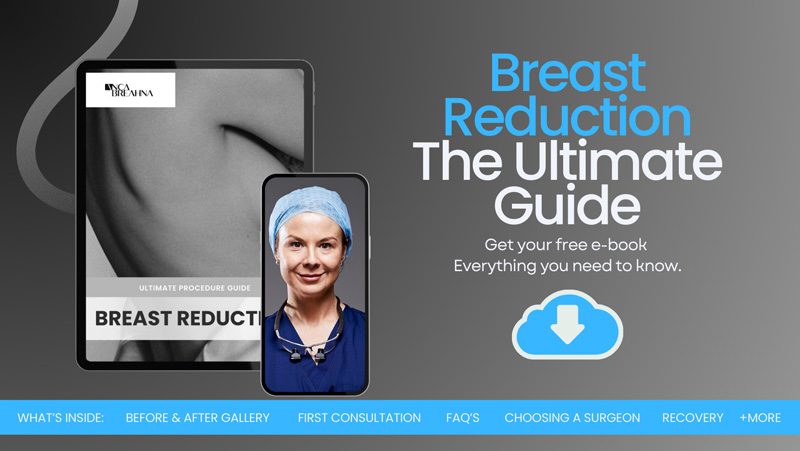
What Breast Size to Expect after Breast Reduction Surgery
Breast reduction surgery offers more than just an aesthetic enhancement—it promises a life free from chronic pain and other complications associated with overly large breasts. Whether you’re looking to alleviate back pain, improve posture, or simply desire a body shape that feels more ‘you,’ finding the right breast size through reduction surgery can enhance your quality of life by aligning your physical proportions with your lifestyle and personal comfort.
In this blog, Consultant Plastic Surgeon Anca Breahna will give you more details about how to choose the right size for breast reduction surgery.
Download the Breast Reduction Guide

Why Consider Breast Reduction?
Health Benefits
Imagine a life where each step isn’t shadowed by back pain, where you don’t have to deal with chronic neck strain, or where daily discomfort becomes a thing of the past. For many, breast reduction surgery makes this a reality. Large, heavy breasts can create a constant pull on the spine and shoulders, leading to long-term issues such as chronic back, neck, and shoulder pain. By reducing the breast size, this strain is alleviated, significantly reducing or even eliminating these painful symptoms.
Moreover, large breasts can often lead to skin irritations or infections under the breast crease—conditions that are not only uncomfortable but can also be challenging to manage. Reducing the breast size helps to decrease the risk of these complications, contributing to a healthier and more comfortable lifestyle.
Lifestyle and Comfort
With smaller and lighter breasts comes greater mobility and an opportunity to engage in physical activities that may have once seemed daunting or painful. Whether it’s running, yoga, or simply playing with your children, breast reduction can remove physical barriers to active participation. It’s about regaining control over your movements and enjoying life without the constant physical reminder of discomfort.
Beyond physical activities, everyday tasks and choices become easier, too. Finding clothes that fit properly, for instance, can transform shopping from a frustration into a pleasure, opening up new possibilities for self-expression.
Aesthetic Considerations
Breast reduction also carries significant aesthetic benefits. Many patients find that smaller, more proportionately sized breasts enhance their overall body shape, bringing balance and symmetry.
Understanding Breast Reduction Sizes
Choosing the right size for a breast reduction isn’t a guessing game but a precise process tailored to each patient. Anca starts with a comprehensive medical assessment, which takes into account not just your breast size but also your body frame, height, weight, and even skin elasticity. This evaluation helps in determining a breast size that will not only look proportional but will also support your physical health.
During consultations, Anca will discuss your health history and any previous surgeries or medical conditions that could affect the procedure. This approach ensures that the final size recommendation is as safe as it is effective.
Personal Preferences
While medical considerations are important, your personal preferences play a role in the decision-making process. This surgery is, after all, about making you feel comfortable in your skin. During consultations, you’ll have the opportunity to express your desired outcomes and discuss how you envision your post-surgery body. This is your journey, and your feelings about the size you wish to achieve are integral to the process.
Visual Aids
Thanks to advances in technology, Anca can now use 3D imaging and simulations to help you visualise potential outcomes. These tools allow you to see a virtual representation of how different sizes could look on your body, making it easier to make informed decisions. This technology not only helps in setting realistic expectations but also ensures that you are wholly comfortable with your choice before proceeding.
Size Concerns after Breast Reduction

Fear of Too Small/Large
One of the most common anxieties surrounding breast reduction surgery revolves around the fear that the results might not align with expectations—either being too small or too large. It’s essential to realise that the aim of this procedure transcends cosmetic enhancement; it’s fundamentally about improving your quality of life by enhancing both comfort and health.
- Customised Planning: Your journey begins with thorough consultations where the surgeon assesses your unique physical attributes and discusses your personal desires for the surgery. This involves detailed measurements of your current breast size and an evaluation of your overall body shape. These consultations serve as the foundation for developing a surgical plan tailored specifically to your body and goals. The surgeon’s role is to harmonise your wishes with what is medically advisable, ensuring the outcome is both aesthetically pleasing and beneficial to your health.
- Visual Tools: Modern technology in plastic surgery now often includes advanced imaging techniques that allow you to visualise different potential outcomes on your body. This can be incredibly reassuring, providing a virtual glimpse into your post-surgical appearance. These tools enable you to “try on” various breast sizes and see how they might look on your physique, helping to align your expectations with realistic surgical outcomes.
- Experience and Precision: Anca brings a wealth of experience and a meticulous eye for detail to the procedure. Her expertise is not just in performing the surgery, but in understanding how to balance aesthetics with functional benefits. This deep understanding allows her to guide you toward a decision that not only meets your visual expectations but also promotes better health and comfort.
Post-Surgical Changes
Post-operative changes are a significant aspect of the process and setting realistic expectations about this phase is important for patient satisfaction. Immediately following the surgery, it’s common to experience swelling and bruising, which can temporarily distort the new contours of your breasts and make them seem larger.
- Healing Process: The initial weeks post-surgery are marked by significant changes as your body adapts to its new shape. Swelling gradually subsides, and the breast tissue begins to settle. This phase is influenced by several factors, including your body’s natural healing capabilities, age, and the elasticity of your skin. Understanding this process helps in mentally preparing for the changes as they occur, ensuring that you remain patient and informed throughout your recovery.
- Long-term Outlook: It’s also important to discuss the long-term expectations with Anca. While breast reduction results are often stable, they can be affected by various factors over time, such as hormonal shifts, weight changes, and natural ageing.
- Support and Guidance: Anca will provide post-operative care instructions and schedule follow-up visits to monitor your healing and progress.
Scarring after Breast Reduction
Scarring is an inevitable aspect of any surgical procedure, including breast reduction. However, with modern surgical techniques and proper post-operative care, these scars can be effectively managed and significantly minimised.
- Scar Placement and Healing: Common techniques involve making incisions around the areola, vertically down from the areola to the breast crease, and sometimes horizontally along the natural crease under the breast. Over time, these incision lines typically fade and become less noticeable.
- Minimising Scarring: Post-operative care is vital in minimising the appearance of scars. Treatments may include the application of silicone sheets or gels, which have been shown to improve the healing and appearance of scar tissue. Additionally, gentle massage of the scarred areas can promote better healing and less noticeable scars.
- Personalised Care: Every patient’s skin type and healing capacity are different, which means scar management strategies must be customised. Anca will provide tailored advice based on your specific needs and the characteristics of your skin, ensuring the best possible outcome in terms of scarring.
Patient Stories
You can explore the journeys of previous patients through our Before and After Gallery. This gallery showcases a variety of patient photos before and after their breast reduction surgeries, highlighting the changes in appearance that accompany this procedure.
Read through Testimonials where patients share their personal experiences. These stories provide insights into the emotional and physical benefits of breast reduction.
FAQs about Breast Reduction
How long does it typically take to recover fully from breast reduction surgery?
- Recovery from breast reduction surgery varies by individual, but most patients can expect to return to non-strenuous work within 2 to 3 weeks. Full recovery, including the ability to engage in high-impact activities, might take up to 6 weeks. It’s important to follow Anca’s specific advice on recovery timelines based on your particular surgery and health status.
Will my ability to breastfeed be affected by breast reduction surgery?
- Breast reduction surgery may affect your ability to breastfeed, depending on the technique used. Techniques that involve less manipulation of the nipple and areola tend to preserve more of the milk ducts connected to the nipples, potentially retaining the ability to breastfeed. Discuss your desire to breastfeed with Anca during your consultation so that she can plan the surgery accordingly.
What kind of anaesthesia is used during breast reduction surgery?
- Breast reduction surgery is performed under general anaesthesia, meaning you will be asleep during the procedure and not feel any pain. In some cases, depending on the extent of the reduction and individual health considerations, local anaesthesia with sedation may be used.
Are there any alternatives to surgery for reducing breast size?
- Non-surgical methods for reducing breast size are limited. Lifestyle changes such as weight loss can sometimes reduce breast size if the breasts contain a significant amount of fatty tissue. However, breast tissue itself cannot be reduced significantly without surgery.
How do I know if my insurance will cover breast reduction surgery?
- Breast reduction surgery may be covered by health insurance if it is deemed medically necessary. Criteria for medical necessity typically include chronic pain or other significant symptoms not alleviated by other treatments. Documentation of these symptoms, such as records of visits to physiotherapists, chiropractors, or other specialists, can support your case. It’s essential to contact your insurance provider to understand the specific requirements and process for obtaining coverage approval for your surgery.
What should I expect during the initial consultation for breast reduction surgery?
During your initial consultation for breast reduction surgery, expect a thorough session covering various aspects important for planning and preparation:
- Medical History and Physical Examination: The surgeon will review your medical history and conduct a physical examination of your breasts to determine suitability for surgery and plan the procedure.
- Discussion of Goals and Expectations: You’ll discuss your desired outcomes and receive realistic feedback on what the surgery can achieve in terms of breast size, shape, and relief from physical discomfort.
- Explanation of the Procedure: The surgeon will explain the surgical techniques, the type of anaesthesia used, and what the surgery entails.
- Risks and Potential Complications: Potential risks and complications will be outlined, including how they are managed and their likelihood.
- Postoperative Recovery and Care: Information on the recovery process, including care instructions, pain management, and activity restrictions, will be provided, along with the schedule for follow-up visits.
- Financial and Insurance Considerations: Details about the cost of the surgery and insurance coverage possibilities will be discussed, especially if the procedure might be deemed medically necessary.
- Questions and Concerns: The consultation is an opportunity to ask questions and address any concerns you might have about the procedure, the surgeon’s qualifications, or the facility.
Further Reading about Breast Reduction with Consultant Plastic Surgeon Anca Breahna
- Read more about Breast Reduction Surgery and Age: Considerations for Different Life Stages
- Read more about 8 Myths about Breast Reduction Surgery
- Read more about Breast Reduction for Adolescents and Young Women
- Read more about How Soon Can I Exercise after Breast Reduction Surgery
- Read more about Private Breast Reduction Surgery in UK
- Read more about Breast Reduction and Athletic Performance
- Read more about Solutions for Heavy Breasts
- Read more about Breast Reduction during Menopause
Medical References for Breast Reduction
- Reduction Mammaplasty: What Cup Size Will I Be?
- Can reduction mammoplasty patients be promised a particular size postoperatively?
- Predicting cup size after reduction mammaplasty
- The Standardization of Bra Cup Measurements: Redefining Bra Sizing Language
- 3D Imaging for Planning and Analysis in Aesthetic Breast Surgery

 Ms Anca Breahna, PhD, MSc, FEBOPRAS, FRCS (Plast) is a highly regarded Consultant Plastic Surgeon specialising in the field of Aesthetic and Reconstructive Plastic Surgery. Anca performs a range of
Ms Anca Breahna, PhD, MSc, FEBOPRAS, FRCS (Plast) is a highly regarded Consultant Plastic Surgeon specialising in the field of Aesthetic and Reconstructive Plastic Surgery. Anca performs a range of 